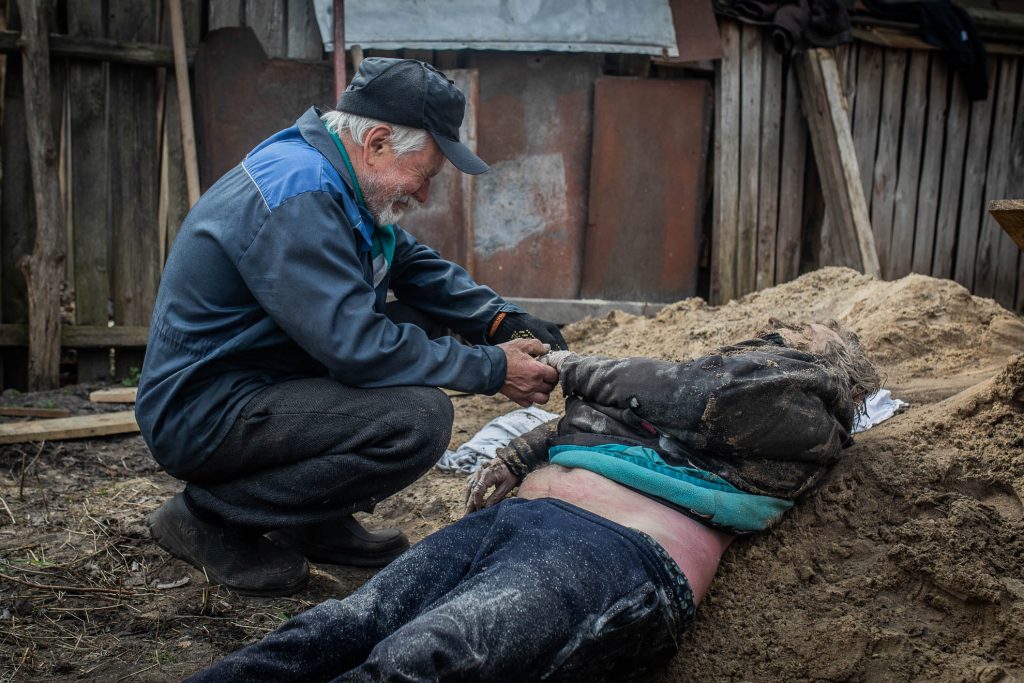Santi Palacios, finalist in the 26th edition of the Luis Valtueña Humanitarian Photography Award
The demand for immediacy does not detract one iota of value from the photojournalistic work by Santi Palacios on the atrocities committed in Bucha (Ukraine) and published a year ago.
The finalist of the 26th edition of the Luis Valtueña Prize portrays in images the horror experienced in this town near Kiev, besieged for a month by the invading Russian troops, who have been deafening the country with their bombardments since 24 February 2022.
Recognised with the most prestigious awards, such as the World Press Photo, Palacios considers that Bucha, which has become one of the symbols of the barbarities perpetrated by the Russian forces in that country, is relevant not only “because the war in Ukraine continues”, but also because what happened in that town “must not be forgotten”.
In Palacios’s opinion, photography is born with “a vocation to endure”, to generate spaces for “reflection” and to awaken “critical thought”.
The photojournalist (1985), who is from Madrid and lives in Barcelona, tells how in the last days of March 2022, after travelling to Kiev as soon as the invasion began, he waited for the moment to approach the combat zones. “Every day we were able to advance a little further,” he recalls, until on 2 April, together with a group of Greek comrades, he managed to enter Bucha.
The scene in Bucha was Dantesque, with corpses strewn in the streets.
“What we found was Dantesque,” he says. Bodies were strewn in the streets, on the asphalt and on the pavements, with obvious signs of violence.
In one of the snapshots that make up the photo essay, Palacios focuses on more than a dozen people lying on the road and the pavement of one of the streets. Some of them were handcuffed, others wore white armbands used by civilians as a sign of neutrality, and most were apparently shot dead.
He recalls how, upon arrival, neighbours approached the press cars to accompany them to learn about the atrocities committed there.
Palacios photographed other shocking scenes, such as the eight corpses of men with their hands tied behind their backs in the courtyard of a building that served as headquarters for Russian troops in Bucha. These images join others such as that of a father digging up his son in the garden of his house so that an autopsy could be carried out on him, or that of a naked woman in the basement of a house with part of her body burnt.
“The signs of violence on the corpses, the desolation of the landscape, the shocked faces of the survivors and their testimonies spoke of a massacre”, the scale of which became clearer as the days went by, Palacios notes. The discovery of a large number of civilian casualties prompted the International Criminal Court to open an investigation into possible war crimes committed by Russia.

Strong emotions and sensations in a desolate city
The photojournalist does not forget “the very strong emotions and sensations” experienced during those days in a desolate city, in which conversations were shared both with relatives of those killed and with people locked in cellars during the month-long occupation.
Some 3,500 people were trapped and suffered from violence and fear, shelling, lack of electricity, water and heating.
Documenting issues that need change
“Documenting problems that interest me, that are relevant, that need to change, making people aware of what is happening, making people think, generating empathy when necessary and helping to generate critical thinking”, is the driving force behind this photojournalist who has won the National Photojournalism Award on two occasions, 2015 and 2016, and winner of the Luis Valtueña Award in 2020.
For this reason, and aware that “it is difficult for a photo to have a second life”, Palacios is optimistic about the fact that his finalist work will be shown in the exhibition that will be on display in Madrid from 4 to 28 April in the La Lonja de Arganzuela hall, because he emphasises: “Photographs last over time, one thing is the immediate impact and another thing is the value as a document, a historical document, after the years those photographs will be there”.
The first reason for a report is to publish it, he says, adding that it is a shame “that it stays there, with all the effort involved, a photograph is not made to be looked at only once, spaces must be created to look at them again, to reflect and generate critical thought”.
Lack of funding for quality work
Dedicated for many years to covering migratory routes and armed conflicts, Palacios collaborates with news agencies and international media such as Associated Press, CNN, New York Times and Sunday Times, among others.
He is committed and always carries out his work with the utmost respect, “because – he assures us – the link is also personal with the people photographed”. He emphasises that working in the field involves difficulties, but they are not “the ones that frustrate us the most, but the funding to do quality work”. A photographer of migratory routes and international conflicts, among his most immediate projects is the development of the Sonda Internacional project, an independent, non-profit media outlet specialising in visual journalism on the climate crisis. The photojournalist concludes that this is “the most important problem we have at a global level” and one on which it is very difficult to generate images that have an impact.
Mercedes Bermejo




